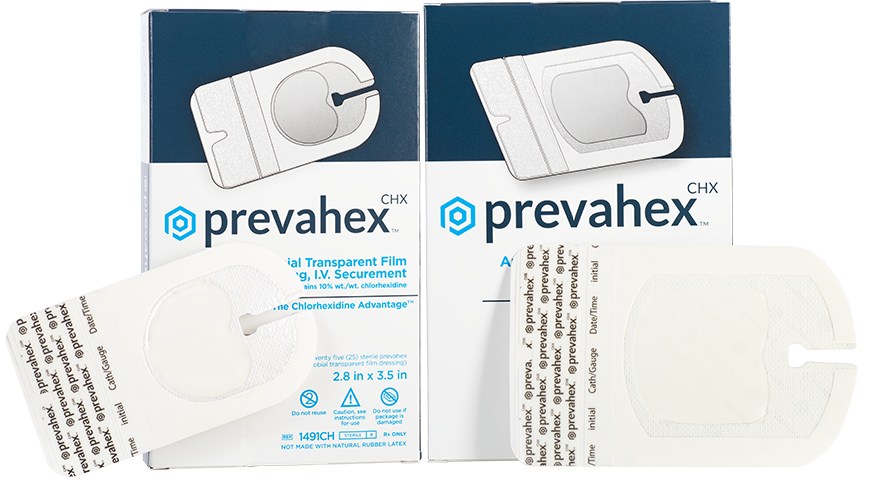Revolutionizing the Final Step of Infection Prevention
PrevahexCHX® is the first and only CHX dressing cleared by the FDA with complete antimicrobial protection throughout the transparent areas of the dressing. PrevahexCHX® antimicrobial dressings incorporate groundbreaking technology utilizing pure chlorhexidine, providing rapid, broad-spectrum dressing protection at wound and intravenous (IV) catheter sites.
New evidence shows that catheter-related bloodstream infections (CRBSIs) and surgical site infections (SSIs) continue to cause unnecessary illness, healthcare costs and death in hospitals across the country. Research suggests that to better protect our patients, we may need to alter our approach.1
-
2,000,000
healthcare associated infections annually2
-
-
80,000
lives lost
-
-
$45B
unnecessary healthcare costs2
-
-
1
breakthrough solution
Blog
Read the Blog
Read, Is it time to move beyond CLABSI?, on The Future of Medicine blog to learn why the medical community is increasingly recognizing how infections associated with other types of vascular access devices are putting patients at risk.
Podcast
Listen to the Podcast
Epidemiologist Robert Garcia, an infection specialist with over 40 years of hospital experience, talks to Patient Safety & Quality Healthcare Editor-in-Chief Jay Kumar on PSHQ: The Podcast, regarding the need to improve infection control in vascular access.
White Paper
Download the White paper
This white paper provides relevant information emphasizing the need to establish the prevention of Hospital-Onset Bacteremia (HOB), an evolving and broad prevention concept that addresses all IV catheters and that may be advanced with use of evolutionary antimicrobial dressings.
Research Highlights the Importance of Infection Prevention
- Skin bacteria is the primary cause of infections.3
- Skin antiseptics cannot sterilize the skin and they provide limited efficacy attributed, in part, to their poor permeation into the deeper layers of the skin.4
- Post skin antisepsis regrowth of bacteria can occur within one day.5
- Skin flora suppressed by skin antisepsis prior to catheter insertion can rapidly grow back and invade the wound.5

“The biggest draw for me to use this product was the Chlorhexidine antimicrobial component within the PrevahexCHX dressing to decrease the skin flora in the incisional area as the incision is commencing the healing process. There has not been any report of skin irritation, infection or rejection from any of the patients or nursing staff. Due to this experience, other members of our surgical staff are now also using PrevahexCHX.”
- John S. Foor M.D., F.A.C.S.
See Footnotes
1 Ryder, Marcia PhD. Healthcare Acquired Infections: Unfortunate Complication or Medical Error. Journal of Consumer Attorneys Associations for Southern California Advocate. July 2016
2 Stone, Patricia. Economic burden of healthcare-associated infections: an American perspective. Expert Rev Pharmacoecon Outcomes Res. October 2009; 9(5): pp. 417-422
3 Maki, D.G. Weise, C.E. Sarafin, H.W. A semiquantitative culture method for identifying intravenous-catheter-related infection. New England Journal of Medicine. 1977; 296(23): pp. 1305-1309. Maki, D.G. Alvarado, C.J. Ringer, M. Prospective randomized trial of povidone-iodine, alcohol, and chlorhexidine for prevention of infection associated with central venous and arterial catheters. The Lancet. 1991; 338(8763): pp. 339-343
4 Karpanen, T. Worthington, T. Conway, B. Hilton, C. Elliot, T. and Lambert, P. Penetration of Chlorhexidine into Human Skin. Antimicrobial Agents and Chemotherapy. October 2008; pp. 3633-3636
5 Reference: Maki, D.G., Cobb, L., Garman, J.K., Shapiro, J.M., Ringer, M., Helgerson, R.B. An attachable silver-impregnated cuff for prevention of infection with central venous catheters: A prospective randomized multicenter trial. Am J Med 1988; (85): pp. 307-314.
